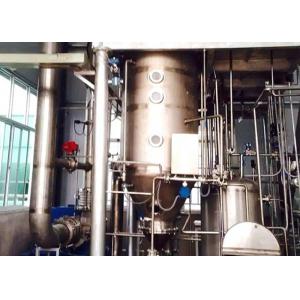MVR Mechanical Vapor Recompression Evaporator For Waste Water Concentration

Engineer-to-order MVR (Mechanical Vapor Recompression) evaporator purpose-built for wastewater concentration, brine volume reduction, and ZLD pre-crystallization. By mechanically recompressing secondary vapor to reuse its latent heat, the system achieves low OPEX, high recovery, and stable operation across variable industrial effluents.
Key Benefits
- Energy efficiency: Electric-driven vapor recompression minimizes fresh steam after start-up.
- High recovery: Deep concentration of high-TDS/COD streams to cut disposal and enable resource recovery.
- Scaling control: Optimized ΔT/LMTD, high-velocity loops, and antiscalant dosing reduce fouling.
- Continuous automation: 24/7 PLC/HMI operation with recipes, alarms, historian, and remote support.
- ZLD-ready: Integrates with crystallizer, centrifuge, and dryer for solids discharge.
Process & Thermal Economy
Secondary vapor is mechanically compressed to raise its saturation temperature and reused as the primary heating medium. Tight control of pressure, ΔT, circulation rate, and vacuum conditions maintains heat-transfer coefficients while protecting quality of condensate for reuse.
Materials & Cleanability
Wetted parts in SS316L/duplex (Ti/Hastelloy on request). Drainable layouts, large clean-outs, CIP provision, and solvent/chemical-compatible elastomers selected per duty.
Process Overview — Wastewater Concentration

- Feed conditioning: screening/filtration, softening or pH trim, and deaeration to limit scaling/corrosion.
- MVR evaporation (vacuum): falling-film or forced-circulation body; compressor discharge sets ΔT.
- Condensate polishing: optional filters/RO/AC to meet reuse or discharge limits (conductivity/TOC guard).
- Concentrate handling: to crystallizer/centrifuge/dryer for solids discharge or further treatment per ZLD.
- Automation: start/stop recipes, load following via VFD, alarm interlocks, and remote diagnostics.
Key Components
- MVR evaporator (falling film / forced circulation) with vapor–liquid separator
- Mechanical vapor compressor (turbo/Roots) with VFD for ΔT/capacity control
- Main heater, preheaters, condensers, vacuum/NCG handling skid
- Instrumentation (T/P/flow/cond/level) with PLC/HMI/SCADA & historian
- CIP skid; antiscalant dosing; optional condensate polishing filters/RO
Performance & Sizing
| Parameter | Typical Range* |
| Operation | Continuous, 24/7 |
| Shell pressure (vacuum) | ~6–25 kPa(abs), duty-dependent |
| Electric use (MVR) | ~15–40 kWh per ton of water evaporated |
| Fresh steam demand | Very low after start-up (backup/ancillary only) |
| Turndown | 50–100% with stable ΔT and quality |
| Materials | SS316L / duplex; Ti/Hastelloy on request |
*Actual performance depends on feed salinity/COD, fouling tendency, compression ratio, and heat-exchanger design.
FAQ
Can it integrate with our existing membranes?
Yes. Common flowsheets pair RO/NF pre-concentration with MVR for final concentration/crystallization before solids handling.
How do you manage scaling on difficult brines?
Through pretreatment, optimized ΔT/LMTD and velocity, antiscalant dosing, and scheduled CIP based on fouling indicators.
What condensate quality can we expect?
Low conductivity/TOC suitable for reuse after polishing; conductivity/TOC guards ensure compliance with site limits.
Application




